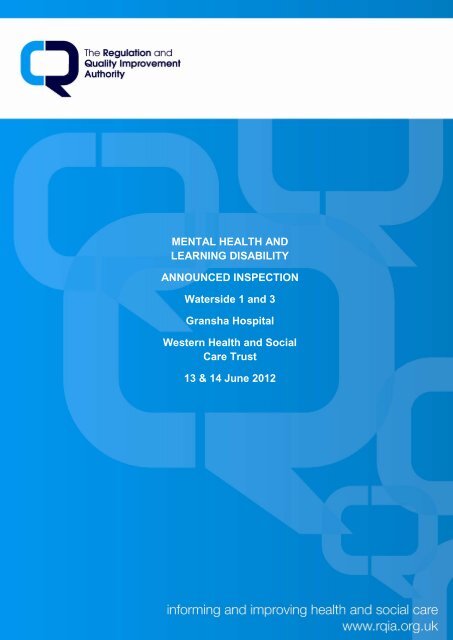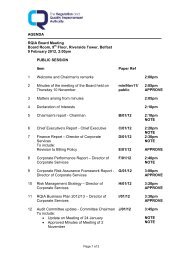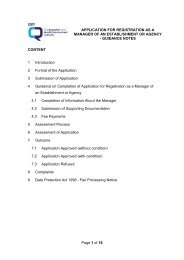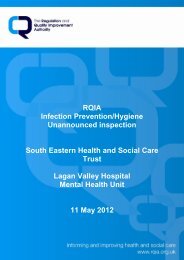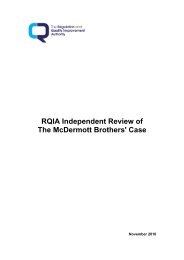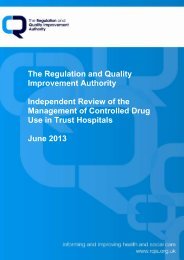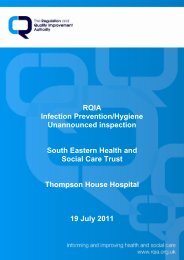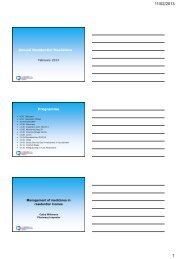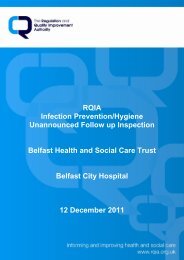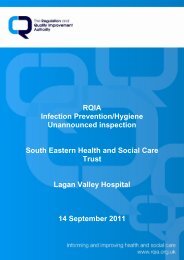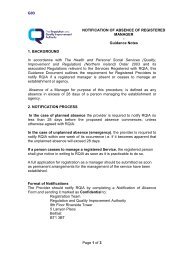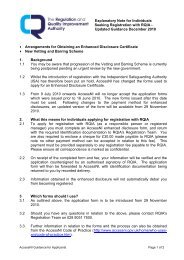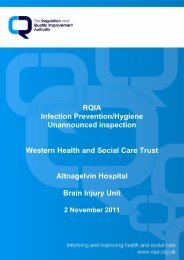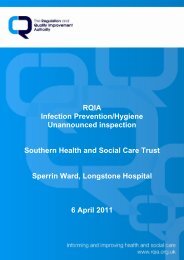Waterside 1 and 3, Gransha Hospital - 13 June 2012
Waterside 1 and 3, Gransha Hospital - 13 June 2012
Waterside 1 and 3, Gransha Hospital - 13 June 2012
Create successful ePaper yourself
Turn your PDF publications into a flip-book with our unique Google optimized e-Paper software.
MENTAL HEALTH AND<br />
LEARNING DISABILITY<br />
ANNOUNCED INSPECTION<br />
<strong>Waterside</strong> 1 <strong>and</strong> 3<br />
<strong>Gransha</strong> <strong>Hospital</strong><br />
Western Health <strong>and</strong> Social<br />
Care Trust<br />
<strong>13</strong> & 14 <strong>June</strong> <strong>2012</strong><br />
1
Table of Contents<br />
1.0 Introduction ............................................................................................ 3<br />
2.0 Ward Profile ........................................................................................... 5<br />
3.0 Inspection Summary .............................................................................. 7<br />
4.0 Stakeholder Engagement ..................................................................... 10<br />
5.0 Additional Concerns Noted by Inspectors ............................................ 12<br />
6.0 RQIA Compliance Scale Guidance ...................................................... 14<br />
7.0 Summary of Compliance – RQIA Assessment ..................................... 15<br />
Appendix 1 – Quality Improvement Plan ........................................................ 18
1.0 Introduction<br />
The Regulation <strong>and</strong> Quality Improvement Authority (RQIA) is the independent<br />
body responsible for regulating <strong>and</strong> inspecting the quality <strong>and</strong> availability of<br />
Northern Irel<strong>and</strong>’s health <strong>and</strong> social care services. RQIA was established<br />
under The Health <strong>and</strong> Personal Social Services (Quality, Improvement <strong>and</strong><br />
Regulation) (Northern Irel<strong>and</strong>) Order 2003, to drive improvements for<br />
everyone using health <strong>and</strong> social care services.<br />
On 24 October 2011 RQIA informed the Western Health <strong>and</strong> Social Care<br />
Trust of the proposed inspection <strong>and</strong> forwarded the associated inspection<br />
documentation. RQIA adopted the approach of self-assessment, which<br />
allowed the ward the opportunity to demonstrate its ability to deliver a service<br />
against best practice indicators. This included the assessment of the trust’s<br />
performance against an RQIA compliance scale, as outlined in section 6.<br />
The inspection process included an analysis of the ward’s self-assessment,<br />
other associated information, discussions with ward staff, patients <strong>and</strong><br />
relatives. A range of multidisciplinary records, policies <strong>and</strong> procedures were<br />
also examined as part of the inspection.<br />
The recommendations made during the previous inspection on 19 <strong>and</strong> 20<br />
April 2011 were also assessed during this inspection to determine the trust’s<br />
progress towards compliance. The inspectors found compliance in the<br />
following areas:<br />
• all informal <strong>and</strong> formal complaints are being consistently recorded<br />
including any actions taken in response<br />
• patients meetings take place on a regular basis<br />
• patients <strong>and</strong>/or carers’ views have been sought <strong>and</strong> communicated at<br />
multi-disciplinary team meetings, however, a further recommendation in<br />
relation to recording templates has been made<br />
• the ward environments had been fully risk assessed in relation to<br />
ligature points <strong>and</strong> any required actions taken<br />
• staffing levels were satisfactory but is is recommended that staffing<br />
levels are reviewed again when <strong>Waterside</strong> 1 reopens<br />
• staff were satisfied that they had been informed of the thresholds for<br />
contacting medical staff in an emergency situation<br />
• records demonstrated that staff complete documentation in relation to<br />
accidents <strong>and</strong> incidents accurately <strong>and</strong> in a timely manner<br />
In spite of assurances from the trust, several recommendations remained<br />
outst<strong>and</strong>ing from the previous inspection. Any previously stated<br />
recommendations that were outst<strong>and</strong>ing were added to the quality<br />
improvement plan for action (reference Appendix 1). Evaluation of compliance<br />
with recomendations in relation the environment in <strong>Waterside</strong> 1 <strong>and</strong> activity<br />
provision have been deferred to the next inspection.<br />
3
An overall summary of the ward’s performance against the human rights<br />
theme of Protection is in Section 3 <strong>and</strong> full details of the inspection findings<br />
are outlined in Appendix 2.<br />
4
2.0 Ward Profile<br />
Trust<br />
Name of hospital/facility<br />
Address<br />
Western Health <strong>and</strong> Social Care Trust<br />
<strong>Gransha</strong> <strong>Hospital</strong><br />
Clooney Road<br />
Derry<br />
BT47 6WH<br />
Telephone number 028 7186 0007<br />
Person in charge on day of<br />
inspection<br />
Nature of service - MH/LD<br />
Name of ward/s <strong>and</strong> category of<br />
care<br />
Number of patients <strong>and</strong> occupancy<br />
level on days of inspection<br />
Sr Winifred O’Kane<br />
Mental Health<br />
<strong>Waterside</strong> 1 - older people with<br />
dementia<br />
<strong>Waterside</strong> 3 older people with<br />
functional mental ill health<br />
16<br />
Number of detained patients on<br />
days of inspection<br />
2<br />
Date of last inspection 19 <strong>and</strong> 20 April 2011<br />
Name of Inspector<br />
Rosaline Kelly<br />
Date of Inspection <strong>13</strong> <strong>and</strong> 14 <strong>June</strong> <strong>2012</strong><br />
Ward profile<br />
<strong>Waterside</strong> <strong>Hospital</strong> is an older people’s care unit on the main <strong>Gransha</strong><br />
<strong>Hospital</strong> site. <strong>Waterside</strong> 1 is an assessment <strong>and</strong> rehabilitation ward for people<br />
with dementia. <strong>Waterside</strong> 3 is a ward for older people with functional mental ill<br />
health.<br />
5
At the time of the inspection on <strong>13</strong> <strong>and</strong> 14 <strong>June</strong> <strong>2012</strong> <strong>Waterside</strong> 1 had been<br />
closed for renovations since 9 March <strong>2012</strong>. Patients from <strong>Waterside</strong> 1 had<br />
been accommodated in <strong>Waterside</strong> 3. Staff from <strong>Waterside</strong> 1 were working in<br />
<strong>Waterside</strong> 3.<br />
Accommodation in <strong>Waterside</strong> 3 included; two day spaces where patients also<br />
dined; a combination of four beds, two bed <strong>and</strong> single rooms, bathrooms <strong>and</strong><br />
toilets; a nurses station; offices <strong>and</strong> a small kitchen. The ward manager stated<br />
that staff tried to accommodate <strong>Waterside</strong> 1 patients separately from<br />
<strong>Waterside</strong> 3 patients. There was also access to an enclosed garden. A range<br />
of different types of seating was available.<br />
<strong>Waterside</strong> 1 was still being renovated to enhance the environment to reflect<br />
best practice in dementia design. At the conclusion of the inspection it was<br />
agreed with a senior Western Trust representative that <strong>Waterside</strong> 1 would<br />
reopen by 31 July <strong>2012</strong>.<br />
There were 16 patients on the ward during the inspection. Two patients had<br />
been detained in accordance with the Mental Health (NI) Order 1986.<br />
6
3.0 Inspection Summary<br />
An announced inspection of <strong>Waterside</strong> 1 <strong>and</strong> 3 was undertaken on <strong>13</strong> <strong>June</strong><br />
<strong>2012</strong> from 9.30am – 5pm <strong>and</strong> 14 <strong>June</strong> <strong>2012</strong> from 10am – 5pm. The<br />
inspectors were Rosaline Kelly <strong>and</strong> Patrick Convery. The purpose of this<br />
inspection was to assess the ward’s arrangements <strong>and</strong> procedures for<br />
safeguarding vulnerable adults.<br />
The following is a summary of the inspection findings of the<br />
arrangements for safeguarding vulnerable adults on this ward.<br />
The ward’s safeguarding statement, policies procedures <strong>and</strong> guidelines were<br />
displayed in the office. A safeguarding folder containing local <strong>and</strong> regional<br />
guidance documents was available. A flowchart describing the vulnerable<br />
adult investigation process was also displayed in the office. Professional<br />
registration bodies guidance documents were also available. Safeguarding<br />
practices were supported by a range of complimentary policies <strong>and</strong><br />
procedures. Recommendations have been made in relation to review of<br />
polcies <strong>and</strong> procedures in a systematic manner.<br />
Staff who met with inspectors appeared to be knowledgeable in relation to<br />
indicators of abuse <strong>and</strong> how to respond to alleged, suspected or actual abuse.<br />
Guidance for staff on how to recognise <strong>and</strong> respond to alleged, suspected or<br />
actual incidents of abuse was available. A code of behaviour has yet to be<br />
developed. However, staff who met with the inspectors were able to describe<br />
various other established frameworks that they use to guide practice, such as<br />
Nursing <strong>and</strong> Midwifery Council Code of Professional Conduct for Nurses <strong>and</strong><br />
could describe what they believed the content of a code of behaviour should<br />
refer to.<br />
Review of training records available on the day of the inspection<br />
demonstrated that 25% staff for both wards did not have a recorded date of<br />
attendance at training in safeguarding vulnerable adults. Deficits in updated<br />
training were also identified during the inspection. These shortfalls in training<br />
had also been highlighted at the last inspection. Senior trust representatives<br />
stated their belief during feedback that the records presented during the<br />
inspection may not be a true reflection of training attendance <strong>and</strong> that some<br />
work is required to update the trust computerised system. It was agreed that<br />
the recommendations made to review records <strong>and</strong> address deficits in<br />
essential training will be addressed as a matter of urgency. Guidance for staff<br />
in relation to protecting vulnerable adults had not been included in the<br />
induction programme. Other recommendations in relation to the induction<br />
programme have been made.<br />
7
Although records of appraisal <strong>and</strong> formal supervision meetings were available<br />
for some staff, formal supervision <strong>and</strong> appraisal of staff, including nursing<br />
auxillary staff had not been occurring in accordance with policies <strong>and</strong><br />
procedures. Recommendations have been made. The ward is not currently<br />
using volunteers.<br />
Risks had been assessed on admission to the ward by both nursing <strong>and</strong><br />
medical staff <strong>and</strong> immediate actions plans defined. Risk had been reviewed.<br />
However, it was concerning that in relation to one particular serious incident<br />
for particular patient, the comprehensive risk assessment had not been<br />
updated to include details of the event or the additionally identified risk <strong>and</strong><br />
related management plan. Although there was some evidence available<br />
during the inspection to demonstrate that those patients usually<br />
accommodated solely in <strong>Waterside</strong> 3 had been involved in the initial<br />
assessment of need, there was not any evidence available to confirm that<br />
patients <strong>and</strong>/or their representatives had been comprehensively involved in<br />
needs assessment <strong>and</strong> care planning.<br />
The ward manager demonstrated a computerised reporting system for<br />
accident, incidents <strong>and</strong> near misses. Referral to other members of the<br />
multidisciplinary team had been made where necessary, including the trusts<br />
vulnerable adults safeguarding team. However, the ward manager stated that<br />
she did not receive information from the trusts Governance department in<br />
relation to analysis of accidents/incidents, <strong>and</strong> was not aware how to generate<br />
this information from the computer programme herself.<br />
Records demonstrated that relatives had been informed of any<br />
accidents/incidents. Detailed minutes of discussions with family members in<br />
conjunction with multidisciplinary team meetings were included in patient files<br />
reviewed during the inspection. A complaints leaflet was available. Records of<br />
formal <strong>and</strong> informal complaints were also available. Discussion with relatives<br />
during the inspection <strong>and</strong> responses made via questionnaires indicated that<br />
any concerns raised were addressed to the satisfaction of those involved.<br />
A reference to record keeping responsibilities was included in minutes of staff<br />
meetings available on the day of the inspection. Policies <strong>and</strong> procedures to<br />
guide staff were available. However, review of nursing care plans <strong>and</strong> nursing<br />
records during the inspection did not demonstrate consistent recording or<br />
accurate record keeping. The ward manager stated that audit of compliance<br />
with recording <strong>and</strong> records management was not taking place. A<br />
recommendation has been made. Policies <strong>and</strong> procedures are in place to<br />
govern the requests of relatives or representatives who may wish to access<br />
8
information <strong>and</strong> patients of <strong>Waterside</strong> 3 who may request access to<br />
information held about them.<br />
The ward manager reported that seclusion <strong>and</strong> restraint are not used in either<br />
<strong>Waterside</strong> 1 or <strong>Waterside</strong> 3. Patients had free access to the enclosed garden<br />
during the inspection <strong>and</strong> were observed using the garden spaces. Practices<br />
of close observation had been documented in patient notes <strong>and</strong> agreed with<br />
the medical staff in accordance with the trusts policy <strong>and</strong> procedures.<br />
Restriction/restraint in terms of use of bedrails was in place for some<br />
individual patients. Bedrails assessments in patients’ notes were reviewed<br />
during the inspection. However documentation had not always been fully<br />
completed <strong>and</strong> this was discussed with the ward manager. Doors to the wards<br />
are locked. The reason for locked doors had not been fully explained in the<br />
ward booklet, or in individual care plans. This had also been highlighted at the<br />
last inspection.<br />
A policy <strong>and</strong> procedure for h<strong>and</strong>ling patients’ finances was available. The<br />
ward does not h<strong>and</strong>le patients’ monies. Patients who are admitted to the ward<br />
with sums of money are asked to h<strong>and</strong> the money to relatives or sign the<br />
money to the hospital cash office in accordance with the policy <strong>and</strong> procedure.<br />
Property lists were recorded on admission to the ward. Five patients<br />
responded to questionnaires issued by RQIA. One respondent stated that<br />
personal items had been taken <strong>and</strong> found on another patient’s locker. A<br />
patient who met with inspectors during the inspection stated that personal<br />
belongings <strong>and</strong> valuable items had been taken <strong>and</strong> not recovered. This<br />
patient stated that personal items appeared to be less secure since both<br />
wards combined. The ward manager agreed that these circumstances were<br />
concerning <strong>and</strong> that lockable storage for patients to keep valuable items <strong>and</strong><br />
personal belongings safe had not been provided.<br />
Inspectors would like to thank the patients, staff, relatives <strong>and</strong> visiting<br />
professionals for their cooperation throughout the inspection process.<br />
9
4.0 Stakeholder Engagement<br />
Questionnaires were issued to staff, patients, relatives, carers <strong>and</strong> visiting<br />
professionals in advance of the inspection. The responses from the<br />
questionnaires were used to inform the inspection process.<br />
Questionnaires issued to Number issued Number returned<br />
Patients 16 5<br />
Carers/Relatives 16 3<br />
Visiting Professional 5 0<br />
Staff 10 3<br />
During the inspection the inspector has the opportunity to meet with staff,<br />
patients, relatives, carers, visiting professionals or advocates. Below are the<br />
details of the number of discussions held during the inspection.<br />
Additional discussions during inspection<br />
Number<br />
Patients 1<br />
Carers/Relatives 2<br />
Visiting Professionals 4<br />
Staff 2<br />
Advocates 0<br />
The following information is a summary of feedback received from those who<br />
returned a questionnaire or met with an inspector during the inspection.<br />
Patients:<br />
Five patients responded to questionnaires issued by RQIA. Comments<br />
included:<br />
“Staff always willing to help all patients, answer questions if asked, food<br />
excellent”<br />
“ward freezing cold”<br />
“Care varies”<br />
“Care very good”.<br />
10
Carers/ Relatives:<br />
Two carers/relatives were interviewed during inspection. They were very<br />
complentary about care <strong>and</strong> treatment received;<br />
“fantastic nursing…very high st<strong>and</strong>ard.”<br />
Three relatives/carers responded to questionnaires issued by RQIA.<br />
Comments included:<br />
“Excellent, all staff are very attentive, professional <strong>and</strong> friendly. Excellent care,<br />
staff, facilities <strong>and</strong> activities”<br />
“Most staff are caring but they engage with patients as little as possible. The<br />
ward is full of elderly patients with dementia <strong>and</strong> some staff treat them in an<br />
abrupt <strong>and</strong> brusque manner…I would suggest more interaction with patients<br />
<strong>and</strong> more planned activity”<br />
“The staff are mostly caring <strong>and</strong> try to be helpful”<br />
Visiting professionals:<br />
Two consultant psychiatrists <strong>and</strong> two team leaders were interviewed during<br />
inspection. There were some concerns expressed regarding the admission<br />
process <strong>and</strong> the assessment <strong>and</strong> management of risk. The perception from<br />
staff interviewed that the number of inappropriate admissions especially at<br />
weekends <strong>and</strong> that despite the multi disciplinary assessment the role of<br />
management in the admission process tended to override professional<br />
decision making <strong>and</strong> the ward could not refuse admission regardless of the<br />
assessment process.<br />
Staff:<br />
Only one member of staff responded to questionnaires issued by RQIA.<br />
Comments included:<br />
“The care provided on this ward is of a high st<strong>and</strong>ard, good communication<br />
with patients <strong>and</strong> families, all care is person centred, unique to each<br />
individual”<br />
Advocates:<br />
The ward does not currently have a formal advocacy arrangement.<br />
11
5.0 Additional Concerns Noted by Inspectors<br />
Nursing Records<br />
Review of nursing records, including care plans, during the inspection,<br />
demonstrated an inconsistent method of needs assessment, risk assessment<br />
<strong>and</strong> subsequent care plans <strong>and</strong> management plans. Some plans used a<br />
numbering reference, other plans in the same patient files were numerically<br />
labelled. Identified needs <strong>and</strong> risks did not always result in a relevant <strong>and</strong><br />
appropriate care plan or risk management plan. Records did not include a<br />
date of creation, <strong>and</strong> some were not signed. Care plans were preprinted<br />
generic documents <strong>and</strong> had not been personalised. Daily entries included<br />
reference to care plans that were not included in the patient file. There was<br />
limited evidence that patients <strong>and</strong>/or carers had been involved in the care<br />
planning process. Examples of all of these concerns were discussed with the<br />
ward manager during the inspection. The ward manager was also directed to<br />
NMC guidance on record keeping that includes the following:<br />
• NMC (2007) “The quality of a registered nurse’s record keeping is a<br />
reflection of the st<strong>and</strong>ard of professional practice. Good record keeping<br />
is a mark of a skilled <strong>and</strong> safe practitioner, whilst careless or<br />
incomplete record keeping often highlights wider problems with that<br />
individuals practice.”<br />
• NMC (2010) “Good record keeping is an integral part of nursing <strong>and</strong><br />
midwifery practice <strong>and</strong> is essential to the provision of safe <strong>and</strong> effective<br />
care. It is not an optional extra to be fitted in if circumstances allow.”<br />
“By auditing records <strong>and</strong> acting on the results you can assess the<br />
st<strong>and</strong>ard of the record keeping <strong>and</strong> communication. This will allow you<br />
to identify any areas where improvements might be made.”<br />
Concerns in relation to record keeping, assessment of need <strong>and</strong> appropriate<br />
related care plans, personalisation, consistency, <strong>and</strong> involvement of patients<br />
<strong>and</strong>/or relatives had been highlighted at the last inspection.<br />
12
5.1 Completion of Works to <strong>Waterside</strong> 1 <strong>and</strong> Use of Living Space in<br />
<strong>Waterside</strong> 3 as Patient Accommodation.<br />
RQIA was informed by the trust that refurbishment of <strong>Waterside</strong> 1 would<br />
commence 9 March <strong>2012</strong> for a period of six weeks. At the time of the<br />
inspection on <strong>13</strong> <strong>and</strong> 14 <strong>June</strong> <strong>2012</strong> the refurbishment works had not been<br />
completed. Concerns in relation to the length of time of the refurbishment <strong>and</strong><br />
impact for patients of both <strong>Waterside</strong> 1 <strong>and</strong> <strong>Waterside</strong> 3 were discussed with<br />
the Head of Older People’s Mental Health Services. Assurances were given<br />
that the works would be completed <strong>and</strong> patients able to move back to<br />
<strong>Waterside</strong> 1 by 31 July <strong>2012</strong>.<br />
The use of a living space to accommodate a patient in <strong>Waterside</strong> 3 was also<br />
discussed with the head of service <strong>and</strong> lead nurse for mental health.<br />
Assurances were given that this had been an emergency situation <strong>and</strong> that it<br />
would not recur.<br />
5.2 Availability of catering resources after hours<br />
Concerns were highlighted by the ward manager that there was a lack of<br />
availability of tea <strong>and</strong> coffee making facilities, bread, cereals, snacks, cups<br />
<strong>and</strong> utensils after hours. Discussion of concerns with the catering manager<br />
resolved these issues on the day of the inspection with agreement to ensure<br />
that these items are available <strong>and</strong> restocked on a daily basis by the catering<br />
team. RQIA will contine to monitor this arrangement.
6.0 RQIA Compliance Scale Guidance<br />
Guidance - Compliance statements<br />
Compliance statement<br />
0 - Not applicable<br />
1 - Unlikely to become<br />
compliant<br />
2 - Not compliant<br />
3 - Moving towards<br />
compliance<br />
4 - Substantially<br />
Compliant<br />
5 - Compliant<br />
Definition<br />
Compliance with this criterion<br />
does not apply to this ward.<br />
Compliance will not be<br />
demonstrated by the date of the<br />
inspection.<br />
Compliance could not be<br />
demonstrated by the date of the<br />
inspection.<br />
Compliance could not be<br />
demonstrated by the date of the<br />
inspection. However, the service<br />
could demonstrate a convincing<br />
plan for full compliance by the<br />
end of the inspection year.<br />
Arrangements for compliance<br />
were demonstrated during the<br />
inspection. However, appropriate<br />
systems for regular monitoring,<br />
review <strong>and</strong> revision are not yet in<br />
place.<br />
Arrangements for compliance<br />
were demonstrated during the<br />
inspection. There are appropriate<br />
systems in place for regular<br />
monitoring, review <strong>and</strong> any<br />
necessary revisions to be<br />
undertaken.<br />
Resulting Action in<br />
Inspection Report<br />
A reason must be clearly stated<br />
in the assessment contained<br />
within the inspection report<br />
A reason must be clearly stated<br />
in the assessment contained<br />
within the inspection report<br />
In most situations this will result<br />
in a requirement or<br />
recommendation being made<br />
within the inspection report<br />
In most situations this will result<br />
in a recommendation being made<br />
within the inspection report<br />
In most situations this will result<br />
in a recommendation, or in some<br />
circumstances a<br />
recommendation, being made<br />
within the Inspection Report<br />
In most situations this will result<br />
in an area of good practice being<br />
identified <strong>and</strong> being made within<br />
the inspection report.<br />
14
7.0 Summary of Compliance – RQIA Assessment<br />
No.<br />
Question<br />
Compliant<br />
Substantially<br />
Compliant<br />
Moving<br />
Towards<br />
Compliance<br />
Not<br />
Compliant<br />
Unlikely to<br />
become<br />
compliant<br />
Not<br />
Applicable<br />
1<br />
2<br />
3<br />
4<br />
5<br />
6<br />
7<br />
8<br />
How do you ensure that<br />
everyone involved with the<br />
ward is aware of <strong>and</strong><br />
underst<strong>and</strong>s the safeguarding<br />
vulnerable adult policy?<br />
List the additional procedures<br />
<strong>and</strong> guidelines that you use to<br />
support the safeguarding<br />
vulnerable adult policy.<br />
List the additional procedures<br />
<strong>and</strong> guidelines, aimed at<br />
promoting safe <strong>and</strong> healthy<br />
working practices, which you<br />
use to support the safeguarding<br />
vulnerable adult policy.<br />
Outline how the ward is<br />
involved in the review of the<br />
trust’s safeguarding vulnerable<br />
adult policy, the code of<br />
behaviour <strong>and</strong> the other<br />
associated procedures <strong>and</strong><br />
guidelines.<br />
Outline how new staff are<br />
appropriately inducted into the<br />
ward.<br />
Describe how staff training<br />
needs, appropriate to the post/<br />
role, are identified.<br />
Outline the arrangements in<br />
place for:<br />
(i) the support <strong>and</strong> supervision<br />
of all staff<br />
(ii) the annual appraisal of staff<br />
<strong>and</strong> the review of volunteers<br />
Describe the arrangements in<br />
place for maintaining written<br />
records of: training completed;<br />
support <strong>and</strong> supervision; <strong>and</strong><br />
annual appraisals <strong>and</strong> reviews.<br />
<br />
<br />
<br />
<br />
<br />
<br />
<br />
<br />
15
9<br />
10<br />
11<br />
12<br />
<strong>13</strong><br />
14<br />
15<br />
16<br />
17<br />
18<br />
Describe how the ward ensures<br />
staff <strong>and</strong> volunteers comply<br />
with the Safeguarding<br />
Vulnerable Adults St<strong>and</strong>ard 4.<br />
Outline the steps the ward has<br />
taken to ensure that staff <strong>and</strong><br />
volunteers are competent to<br />
recognise signs of abuse.<br />
Describe how the ward<br />
identifies <strong>and</strong> manages risks for<br />
individual patients.<br />
Outline the mechanisms used<br />
by the ward to ensure that<br />
vulnerable adults have the right<br />
to take risks in relation<br />
to their care.<br />
Describe how the reporting,<br />
recording <strong>and</strong> reviewing<br />
accidents, incidents <strong>and</strong> near<br />
misses informs <strong>and</strong> influences<br />
ward practice <strong>and</strong> the risk<br />
assessment <strong>and</strong> management<br />
procedures.<br />
Describe how the ward<br />
promotes <strong>and</strong> communicates<br />
the trust’s ethos of inclusion,<br />
transparency <strong>and</strong> openness’ to<br />
vulnerable adults, carers,<br />
advocates, family members,<br />
staff <strong>and</strong> volunteers.<br />
Describe the procedures in<br />
place for carers, advocates <strong>and</strong><br />
vulnerable adults to share<br />
concerns they may have or to<br />
make complaints about the<br />
organisation.<br />
Outline the steps the ward has<br />
taken to encourage carers,<br />
advocates <strong>and</strong> vulnerable<br />
adults to raise concerns or<br />
make a complaint following an<br />
incident.<br />
Outline how the ward ensures<br />
that staff know <strong>and</strong> comply with<br />
the records management<br />
policy.<br />
Outline the mechanisms the<br />
trust has in place to inform<br />
vulnerable adults about their<br />
<br />
<br />
<br />
<br />
<br />
<br />
<br />
<br />
<br />
<br />
16
19<br />
20<br />
21<br />
22<br />
23<br />
24<br />
right to access to information<br />
held about them.<br />
Describe how the ward ensures<br />
that staff, volunteers <strong>and</strong><br />
visitors know about <strong>and</strong> adhere<br />
to the code of behaviour.<br />
outline how the ward<br />
safeguards patients’ rights in<br />
relation to the use of:<br />
(i) restrictions on the ward<br />
(ii) isolation/ seclusion<br />
(iii) close observation<br />
(iv) restraint<br />
Outline the mechanisms for the<br />
h<strong>and</strong>ling of vulnerable adults’<br />
money.<br />
Outline how the ward ensures<br />
the safety of patients’ property<br />
while on the ward.<br />
Describe what arrangements<br />
the ward has in place for<br />
children visiting the ward.<br />
Outline the safeguarding<br />
arrangements the ward has in<br />
place for the admission of an<br />
under 18 year old.<br />
<br />
<br />
<br />
<br />
<br />
<br />
17


